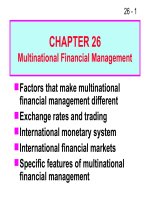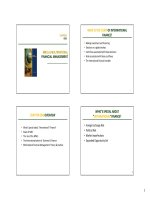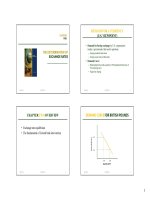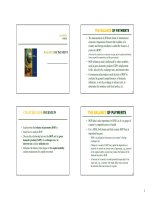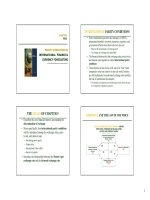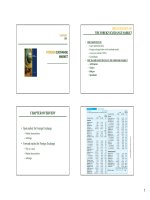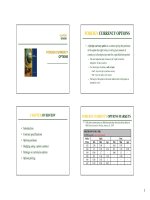Lecture Multinational financial management: Lecture 6 - Dr. Umara Noreen
Bạn đang xem bản rút gọn của tài liệu. Xem và tải ngay bản đầy đủ của tài liệu tại đây (262.89 KB, 12 trang )
Lecture
6
Currency Derivatives
Chapter Objectives
To explain how forward contracts are
used for hedging based on anticipated
exchange rate movements; and
To explain how currency futures
contracts and currency options
contracts are used for hedging or
speculation based on anticipated
exchange rate movements.
Forward Market
• A forward contract is an agreement
between a firm and a commercial bank
to exchange a specified amount of a
currency at a specified exchange rate
(called the forward rate) on a specified
date in the future.
• Forward contracts are often valued at
$1 million or more, and are not normally
used by consumers or small firms.
Forward Market
• When MNCs anticipate a future need
for or future receipt of a foreign
currency, they can set up forward
contracts to lock in the exchange rate.
• The % by which the forward rate (F )
exceeds the spot rate (S ) at a given
point in time is called the forward
premium (p ).
F = S (1 + p )
• F exhibits a discount when p < 0.
Forward Market
Example S = $1.681/£, 90-day F = $1.677/£
annualized p =
=
F – S 360
S
n
1.677 – 1.681
1.681
360 = –.95%
90
The forward premium (discount) usually
reflects the difference between the home
and foreign interest rates, thus preventing
arbitrage.
Forward Market
• A swap transaction involves a spot
transaction along with a corresponding
forward contract that will reverse the
spot transaction.
• A non-deliverable forward contract
(NDF) does not result in an actual
exchange of currencies. Instead, one
party makes a net payment to the other
based on a market exchange rate on
the day of settlement.
Forward Market
• An NDF can effectively hedge future
foreign currency payments or receipts:
April 1
Expect need for 100M
Chilean pesos.
Negotiate an NDF to buy
100M Chilean pesos on
Jul 1. Reference index
(closing rate quoted by
Chile’s central bank) =
$.0020/peso.
July 1
Buy 100M Chilean
pesos from market.
Index = $.0023/peso
receive $30,000 from
bank due to NDF.
Index = $.0018/peso
pay $20,000 to bank.
Currency Futures Market
• Currency futures contracts specify a
standard volume of a particular currency
to be exchanged on a specific settlement
date.
• They are used by MNCs to hedge their
currency positions, and by speculators
who hope to capitalize on their
expectations of exchange rate
movements.
Currency Futures Market
• The contracts can be traded by firms or
individuals through brokers on the
trading floor of an exchange (e.g.
Chicago Mercantile Exchange),
automated trading systems (e.g.
GLOBEX), or the over-the-counter
market.
• Brokers who fulfill orders to buy or sell
futures contracts typically charge a
commission.
Comparison of the Forward & Futures Markets
Contract size
Delivery date
Participants
Security
deposit
Clearing
operation
Forward Markets
Customized
Futures Markets
Standardized
Customized
Banks, brokers,
MNCs. Public
speculation not
encouraged.
Compensating
bank balances or
credit lines needed.
Handled by
individual banks
& brokers.
Standardized
Banks, brokers,
MNCs. Qualified
public speculation
encouraged.
Small security
deposit required.
Handled by
exchange
clearinghouse.
Daily settlements
to market prices.
Comparison of the Forward & Futures Markets
Forward Markets
Futures Markets
Worldwide
telephone
network
Central exchange
floor with worldwide
communications.
Regulation
Self-regulating
Commodity
Futures Trading
Commission,
National Futures
Association.
Liquidation
Mostly settled by
actual delivery.
Mostly settled by
offset.
Transaction
Costs
Bank’s bid/ask
spread.
Negotiated
brokerage fees.
Marketplace
• Source: Adopted from South
Western/Thomson Learning © 2006


